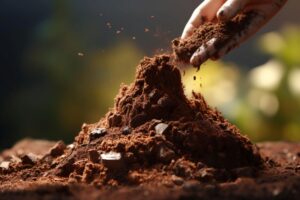Soil organic matter is the term used for all the living and non-living materials within the soil or added to the soil. This includes the roots that develop during the growing seasons, incorporated crop stubble, slurries, or added manures. Every organic matter will contain Carbon (C), Nitrogen (N), Sulphur (S), Phosphorous (P), Magnesium (Mg), Potassium (K), Calcium (Ca), and a wide array of micronutrients like Copper, Zinc, and more.
Soil organic matter is found in different sorts of forms with a range of ages. To make it easy to understand how soil organic matter cycles in the soil and affects soil processes, organic matters are classified into three main pools. They are:
- Fresh plant residues, including the little decaying roots and the small living soil organisms.
- Decomposing organic matter
- Stable organic matter that is linked tightly to the clay minerals is sometimes called humus.
There are some soils that also contain stable minerals that were originally organic matter, like charcoal and coal fragments.
The Purpose of Soil Organic Matter:
Soil organic matter adds to soil fertility and enhances the overall soil health by enhancing the chemical, physical, and the overall biological properties of the soil.
- The fresh plant residues fuel the biological life in the soil.
- The amount of active decomposing organic matter in the soil has a significant impact on the biological properties, soil structure, and nutrient cycling.
- The stable organic matter changes soil color and adds a lot to the active surface area, thus changing the physical and chemical properties and the processes of the soil. This is highly crucial for the sandy and light silty soils.

Source: Freepik
How to Add Organic Matter to the Soil?
The levels of organic matter in a specific soil are the result of the equilibrium between the inputs of organic matter and the decomposition of the organic matter by the soil organisms. The disruption of soil aggregates during tillage changes the distribution and accessibility of organic matter in the soil and usually increases the rates of decomposition. The inputs will vary through the year with the growth of the crops, and the amount of inactivity of roots will change.
Return of the crop residues will also increase the organic matter inputs to the soil. This occurs with better crop yields or the introduction of cover crops in a rotation. Inputs might also be added from outside the field/farm in manures, biosolids, and composts. The actual impacts will depend on the loading rate, and it can take multiple years of repeated management for changes to occur specifically for the soil structural improvements.
The simple rule is that if you add more organic materials, you build more soil organic matter. The measure of soil organic matter applied to a specific area of soil is given in tons per acre (t/ac) or hectare (t/ha). However, it is crucial to be careful about whether this is the total amount or the dry weight. Organic materials will range widely in the water content from 10% to 90%. The amount of carbon applied is related to the total dry matter application. Every ton of dry matter will contain almost 580Kg of carbon.
How to Measure Soil Organic Matter?
How can you know the amount of organic matter present in the soil? The amount of organic matter present in the soil will depend on the following:
- The input of organic materials and the decomposition rate.
- The rate of existing soil organic matter decomposition.
- Environmental factors like soil moisture, temperature, and aeration.
- Soil texture.
It is tough to know the threshold below or above which the soil properties change. It is imperative to measure the soil organic matter periodically to determine the changes and understand the effects of soil management practices. Soil organic matter is concentrated at the surface, and it reduces with the increasing depths unless there is an inversion tillage.
Sampling and Measuring Organic Matter:
The amount of soil organic matter is high compared to the changes due to varying soil management practices in a short time. Therefore, sampling to monitor the changes in soil organic matter must take place periodically. However, it is not useful to measure the soil organic matter every year. Changes can be detected for a field with samples collected in the same way at intervals of 3-5 years over a decade. Detecting the changes in the soil organic matter for a specific area of a land is a slow process. Also, remember that the presence of roots or the added organic materials in the sample might give odd results. Therefore, it is crucial to obtain a mixed sample for analysis from multiple separate soil samples collected in the field.
Measuring soil organic matter is crucial for better agricultural growth. For the best soil mapping and analysis, contact SoilOptix® today! Visit https://soiloptix.com/ for details.
